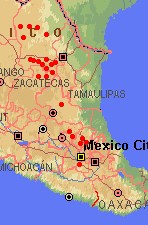
Range of Pinus pinceana (1). Basemap from Expedia Maps.
Common Names
Pince piñon (2).Taxonomic notes
Syn: Pinus latisquama Engelmann 1882 (4). Allied to P. maximartinezii and a little less closely to P. rzedowskii.Description
A small tree reported to 10 m (1, 3, 4), though rarely more than 5-6 m tall or 25 cm dbh (5). Bark smooth pale grey at first, becoming thinly scaly grey-brown at base on older trees. Crown rounded, dense, with irregular branches and pendulous branchlets. Leaves stiffly drooping, soft bright green, in fascicles of 3, sheath mostly deciduous but smallest basal sheath scales often persisting; 6-12 cm long, about 0.8 mm thick, glossy with inconspicuous stomatal bands. Seedlings have only juvenile foliage for several years, with nodding white shoots and single 3 cm leaves, strongly glaucous. Cones pendulous on slender peduncles 1-3 cm long and 3 mm thick; cylindric, 6-11 cm long, 4-5 cm broad, green ripening bright orange and opening to 5-7 cm broad. Scales large, polygonal, smooth, 20-25 mm broad, apophysis flat to weakly raised, with a flat 7 mm wide umbo. Seeds large, 11-13 mm, orange, wing 1-2 mm, vestigial, usually remaining attached to the scale when seed removed. Seeds do not fall naturally from cone, but are dispersed by birds (2); after seed dispersal the cones fall with or without the peduncle. Cones mature in early November about 18-19 months after pollination (5).Range
Mexico: Coahuila, N Zacatecas, San Luís Potosí, Querétaro and Hidalgo (3, 6), at 1500-2300 m altitude (3). It is scarce and scattered in its natural habitat, in very open scrubland in very dry areas; it usually grows mixed with P. cembroides and mixed xerophytic low scrub vegetation including cacti and agaves (5). USDA hardiness zone 9.Big Tree
Oldest
Dendrochronology
Ethnobotany
Observations
This is not an easy pine to see. It occurs scattered in viciously thorny low scrub (Cholla (Opuntia sect. Cylindropuntia), Agave, Ferocactus, etc.) in remote areas with poor roads; but it is well worth the effort. Small stands occur by dirt roads near Cuautemos south of Saltillo; four-wheel drive vehicles or horseback and tough boots are essential. See Perry (3) for directions.Remarks
This species is listed as "LR/nt" (lower risk, near threatened) by the World Conservation Monitoring Centre - Trees database.A highly attractive small tree, one of the most beautiful conifers and ideally suited to small gardens in dry areas, but very rare in cultivation.
Citations
(1) Farjon & Styles 1997.(2) Lanner 1981.
(3) Perry 1991.
(4) Shaw 1909.
(5) M P Frankis, field notes, N E Mexico, November 1991.
(6) Bailey & Hawksworth 1988.
This page edited by M.P. Frankis, Jan-1999.
[Pinus] [Pinaceae] [home]
This page is from the Gymnosperm Database
URL: http://www.geocities.com/~earlecj/pi/pin/pinc.htm
Edited by Christopher J. Earle
E-mail:earlecj@earthlink.com
Last modified on 7-Apr-1999